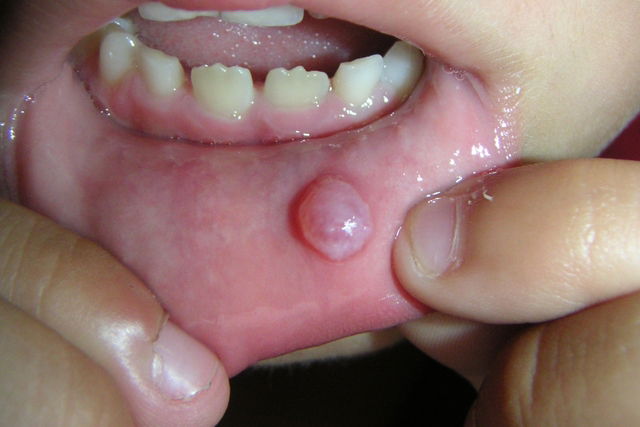Mucocele, also known as mucous cyst, is a type of blister, which forms on the lip, tongue, cheeks or roof of the mouth, usually due to a blow to the region, repetitive biting or a blocked salivary gland.
This benign lesion can range in size from a few millimeters to 2 or 3 centimeters in diameter. It usually does not cause pain, except when it is accompanied by some type of injury.
Mucocele is not contagious and usually resolves on its own without the need for treatment. However, in some cases, minor surgery by a dentist may be necessary to remove the affected cyst and salivary gland.

Main symptoms
Mucoceles are often described as a a kind of bubble, or blister, filled with saliva that are often transparent or purplish in color. They can sometimes be confused for a canker sore, although canker sores are usually more painful and characterized by open ulcers in the mouth, not blisters. See what can cause canker sores and what to do.
After some time, the mucocele may regress or rupture, particularly after a bite or trauma to the region. This can cause a small wound which often heals naturally.
If you have symptoms of a mucocele that persist for more than 2 weeks, you should see your dentist for assessment. There are types of cancer, like mucoepidermoid carcinoma, that can cause similar symptoms. Lesions associated with this cancer usually worsen over time, while mucoceles tend to improve.
What causes a mucocele
Mucoceles are often caused by the blockage or injury of a salivary gland or duct. The most common situations include:
- Biting or sucking the lips or the inside of the cheeks;
- Blows to the face, especially on the cheeks;
- History of other diseases that affect the mucous membranes, such as Sjogren’s syndrome or sarcoidosis, for example.
In addition, mucocele may also appear in newborns soon after birth due to traumas during birth. These rarely require treatment.
Treatment options
Mucoceles often resolve on their own and disappear within a few days without the need for treatment. However, in cases where the lesion continues to grow and gets too big or shows no signs of improving, the dentist may indicate a minor surgery in the office to remove the affected salivary gland and reduce swelling.
This surgery is a simple procedure which does not require hospitalization. Patients are usually discharged home within a few hours and able to return to work or school 1 to 2 days after the surgery.
There are some cases in which removed mucoceles may regrow. Further surgery may be necessary for these cases.
